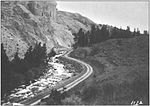North Entrance Road Historic District
North Entrance Road Historic District | |
 | |
| Nearest city | Yellowstone National Park, Montana and Wyoming |
|---|---|
| Coordinates | 45°0′24″N 110°41′58″W / 45.00667°N 110.69944°W |
| Built | 1883 |
| Architect | COE |
| MPS | Yellowstone National Park MPS |
| NRHP reference No. | 02000529 and 02000530 |
| Added to NRHP | May 22, 2002[1] |
The North Entrance Road Historic District comprises Yellowstone National Park's North Entrance Road from Gardiner, Montana to the park headquarters at Mammoth Hot Springs, Wyoming, a distance of a little over five miles (8 km). The North Entrance Road was the first major road in the park, necessary to join the U.S. Army station at Fort Yellowstone to the Northern Pacific Railroad station at Gardiner. The road includes the Roosevelt Arch at the northern boundary of the park and winds through rolling terrain before crossing the Gardner River and joining the Grand Loop Road.[2]
The North Entrance Road is an unsigned portion of US 89.
History
[edit]
The road was planned in 1883 by Lieutenant Dan Kingman of the U.S. Army Corps of Engineers and later on improved by Captain Hiram M. Chittenden of the Corps.,.[3][4] It replaced the old Gardiner High Road which went from behind the Mammoth Hotel north over the ridges west of the river to the town of Gardiner. The first permanent entrance station to house rangers checking vehicle entering the park was constructed in 1921. It replaced temporary tents used by rangers at the Roosevelt Arch.[5]
The road was destroyed in the 2022 Montana floods.[6] Most of the road was washed away by the river.[7] On October 30, 2022, Old Gardiner Road was opened to regular visitor traffic between Gardiner and Mammoth Hot Springs, to bypass the damaged North Entrance Road.[8]
Gallery
[edit]-
Gardner River Crossing, 1901
-
Lower Gardner River, 1923
-
Grand Loop bridge over Gardner River
-
Northern Pacific Railway station at northern end of road.
-
Stagecoaches en route to Mammoth, 1904
-
Stagecoaches at Mammoth
-
Lower Gardner River road, 1912
-
North Entrance Station, 1922
-
North Entrance Station, 1936
-
New North Entrance Station, 1938
-
North Entrance Station, 1949
-
North Entrance Station, 1990
See also
[edit]- Fort Yellowstone
- Grand Loop Road Historic District
- Lake Fish Hatchery Historic District
- Mammoth Hot Springs Historic District
- Roosevelt Lodge Historic District
- Old Faithful Historic District
Further reading
[edit]- Culpin, Mary Shivers (1994). The History of the Construction of the Road System of Yellowstone National Park 1872-1966 (Report). National Park Service.
Notes
[edit]- ^ "National Register Information System". National Register of Historic Places. National Park Service. April 15, 2008.
- ^ "North Entrance Road Historic District". National Register of Historic Places. Wyoming State Preservation Office. October 1, 2008.
- ^ Marcy Shivers Culpin; Christine Whitacre; Catherine Lentz; Lon Johnson (2001). "National Register of Historic Places Inventory-Nomination: North Entrance Road Historic District" (pdf). National Park Service.
{{cite journal}}: Cite journal requires|journal=(help) - ^ Bartlett, Richard A. (1989). Yellowstone-A Wilderness Besieged. Tucson, AZ: University of Arizona Press. pp. 75–80. ISBN 0-8165-1098-9.
- ^ Culpin, Mary Shivers (1994). The History of the Construction of the Road System of Yellowstone National Park 1872-1966 (Report). National Park Service. p. 299.
- ^ Clifford, Catherine (June 16, 2022). "Satellite photos show extent of devastating Yellowstone flood". CNBC. Retrieved June 29, 2022.
- ^ Road washed out at Yellowstone National Park's north entrance, 9news.com, retrieved June 29, 2022
- ^ Warthin, Morgan (October 30, 2022). "Flood Recovery Updates: Yellowstone's North Entrance and road to Mammoth Hot Springs to open TODAY, Oct. 30". National Park Service. Retrieved October 30, 2022.
External links
[edit]- Historic American Engineering Record (HAER) No. MT-93, "North Entrance Road, Between Gardiner, MT & Mammoth Hot Springs, WY, Gardiner vicinity, Park County, MT", 1 color transparency, 11 data pages, 1 photo caption page
- HAER No. WY-7, "Gardner River Bridge, Spanning Gardner River at North Entrance Road, Lake, Teton County, WY", 12 photos, 3 measured drawings, 9 data pages, 1 photo caption page
- National Park Service Video - Old Gardiner Road
- North Entrance Road Historic District at the Wyoming State Historic Preservation Office
- National Register of Historic Places in Yellowstone National Park
- Roads on the National Register of Historic Places in Montana
- Roads on the National Register of Historic Places in Wyoming
- Transportation in Park County, Montana
- Transportation in Park County, Wyoming
- Historic American Engineering Record in Wyoming
- Historic American Engineering Record in Montana
- Historic districts on the National Register of Historic Places in Montana
- Historic districts on the National Register of Historic Places in Wyoming
- National Register of Historic Places in Park County, Montana
- National Register of Historic Places in Park County, Wyoming
- Gates in the United States
- 1883 establishments in the United States
- Buildings and structures in Yellowstone National Park in Montana















